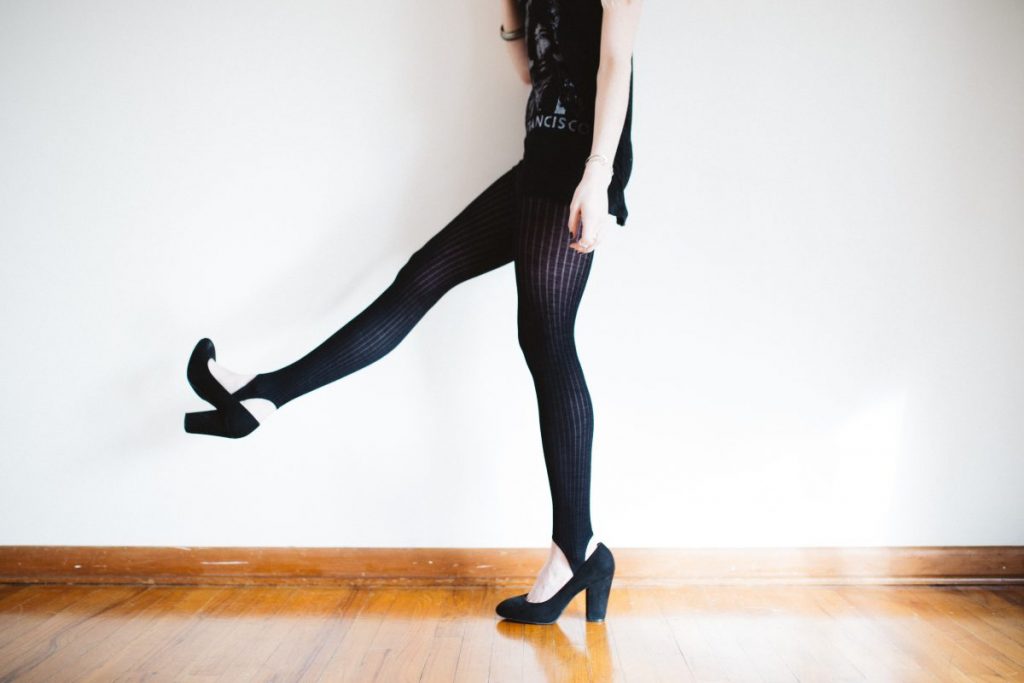Want to read in Dutch? Click here.
A few days ago, I spoke with a customer about her company’s dress code. I was preparing a presentation on the dress code policy that she could share with her employees. And then she touched on one of the more interesting items. Namely leggings.

What should she do about leggings being worn in the workplace? On one person, they look presentable, while on another, they can look unkempt. This got me thinking. Are leggings appropriate in a business environment? And why is it that such a simple garment is also kind of complicated?
More popular than jeans
Leggings are now very popular as everyday wear, but this is a pretty recent trend. Deirdre Clemente, a historian at the University of Nevada in Las Vegas, says that leggings have only been popular as casual wear since the mid-1900s. Up to then, they were only worn by dancers.
The aerobics craze in the 1980s fueled the demand for leggings. And in the eighties and nineties, more leggings than jeans were sold. Around the year 2000, many people switched from aerobics to yoga, and the demand for leisurewear continued to grow. In 2016, sales of spandex pants increased by 40 percent and leggings were still outselling jeans.
Business casual?
Okay, so dancers initially wore leggings followed by people who did aerobics or yoga. Sounds logical. But how did they slowly trickle through to being casual wear in the workplace?
Since Casual Friday entered the office in the late 1990s, the dress code at work has become increasingly relaxed. Casual dress is becoming the norm and being implemented in more and more sectors. Jeans in the workplace are fine, so why not the leggings? After all, they are very comfortable because of the soft, elastic fabric. And they don’t cut at the waist as some pants can.
It is also getting harder to see the difference between leggings and regular pants. Since skinny jeans became popular in the early 2000s, all pants suddenly seemed to be tight fitting. The tighter the better was the trend. And can you tell the difference between leggings and pants? Only the pockets and zipper seem to differentiate them.
Grey area
But in combination with the fabric, it is those small details that determine your appearance. There are plenty of pants on the market today made of a thin, elastic fabric, the difference with leggings is clearly visible.
Leggings are just like thin vests. They cover what they need to cover, but that doesn’t make them appropriate for a business environment. Although they are usually not see-through, they are still pretty revealing. A revealing cleavage in a shirt is what the buttocks are in a pair of leggings. You can of course combine them with a dress or skirt, replacing pantyhose. This is different from wearing them as pants.
Don’t get me wrong, I would be the last person to say we should ban leggings in the workplace. Each company must determine what they find appropriate. But remember that when creating a dress code, you cannot pick and choose who must adhere to it. A dress code is for everyone, including the employee who cannot pull off a pair of leggings. If you want to make an exception, you can only do that with the item of clothing. You can prohibit certain colors or lengths because, for example, they do not suit the company image. Or, for example, employees can only wear leggings with a skirt of a certain length.
This is also how I sometimes wear leggings. In the winter when I want to wear a dress, but it is too cold. On these days, my thermal leggings come out of the closet. Hiding nicely under a skirt and a pair of boots, they can join me in the office again. And after that, as Marie Kondō would say, they can rest in the closet. And contemplate its identity crisis.
Greetings,
Aileen

Hi Aileen!
How are you?
Which Style of Jeans Should I Buy?
Thanks
Elizabeth Emma
I got what you mean,bookmarked, very nice internet site. Karena Burton Declan